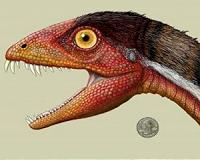| . |  |
. |
Sheffield UK (SPX) Apr 14, 2011 A team of scientists from the University of Sheffield, the University of Oxford and Boston College, who are exploring rocks around Loch Torridon, have discovered the remarkably preserved remains of organisms that once lived on the bottom of ancient lake beds as long as a billion (1,000 million) years ago. These fossils illuminate a key moment in the history of evolution when life made the leap from tiny, simple bacterial (prokaryote) cells towards larger, more complex (eukaryotic) cells which would make photosynthesis and sexual reproduction possible. The findings are reported in Nature. Some of these ancient fossils are so finely ornamented, and so large and complex, that they are evidence for a surprisingly early start for the emergence of complex eukaryote cells on land. The researchers believe that it was from complex cells such as these that green algae and green land plants - everything from lettuce to larch trees - were able to evolve and colonise the land. Around 500 million years after the emergence of these complex cells, the surface of the land was starting to become covered in simple vegetation like lichens, mosses and liverworts, and the first animals were able to take their chance and leave the sea behind. These pioneers were followed by the first fish and ferns, reptiles and conifers, mammals and flowering plants - and, eventually, humans. Dr Charles Wellman, Reader in Palaeobiology at the University of Sheffield's Department of Animal and Plant Sciences, and an author on the paper, said: "It is generally considered that life originated in the ocean and that the important developments in the early evolution of life took place in the marine environment: the origin of prokaryotes, eukaryotes, sex and multicellularity. "During this time the continents are often considered to have been essentially barren of life - or at the most with an insignificant microbial biota dominated by cyanobacteria. We have discovered evidence for complex life on land from 1 billion year old deposits from Scotland. This suggests that life on land at this time was more abundant and complex than anticipated. It also opens the intriguing possibility that some of the major events in the early history of life may have taken place on land and not entirely within the marine realm." Professor Martin Brasier of the University of Oxford's Department of Earth Sciences, an author of the paper, said: "These new cells differ from their bacterial ancestors in that they have specialised structures including a nucleus, as well as mitochondria and chloroplasts - which are vital for photosynthesis. They also undergo sexual reproduction, leading to much more rapid rates of evolutionary turnover. It may even be that the sort of conditions found in the ancient lakes around Loch Torridon favoured a key step in this transformation, which involved the incorporation of symbiotic bacteria into the cell to form chloroplasts, rather than this occurring in the sea as usually envisaged." Professor Brasier added: "None of this would have been possible without advances long ago made by these little microbes, now entombed within phosphate from the Torridon lakes. It was arguably these organisms that helped to turn our landscape from a harsh and rocky desert into a green and pleasant place."
Share This Article With Planet Earth
Related Links University of Sheffield Explore The Early Earth at TerraDaily.com
 Scientists Bridge A Gap With New Species Of Dinosaur
Scientists Bridge A Gap With New Species Of DinosaurWashington DC (SPX) Apr 14, 2011 A team of scientists led by the Smithsonian Institution has discovered a fossilized dinosaur skull and neck vertebrae that not only reveal a new species, but also an evolutionary link between two groups of dinosaurs. The new species, Daemonosaurus chauliodus, was discovered at Ghost Ranch, N.M. The team's findings are published in the Proceedings of the Royal Society B, Wednesday, April 13. ... read more |
|
| The content herein, unless otherwise known to be public domain, are Copyright 1995-2010 - SpaceDaily. AFP and UPI Wire Stories are copyright Agence France-Presse and United Press International. ESA Portal Reports are copyright European Space Agency. All NASA sourced material is public domain. Additional copyrights may apply in whole or part to other bona fide parties. Advertising does not imply endorsement,agreement or approval of any opinions, statements or information provided by SpaceDaily on any Web page published or hosted by SpaceDaily. Privacy Statement |